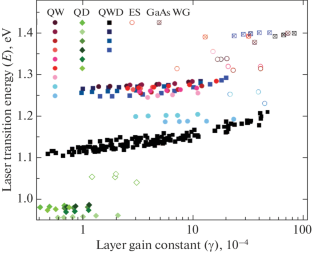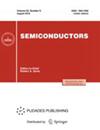基于量子阱、点和阱点的激光器中波长与增益之间的关系
IF 0.6
4区 物理与天体物理
Q4 PHYSICS, CONDENSED MATTER
引用次数: 0
摘要
摘要 对一系列基于量子阱(2D)、量子点(0D)和过渡(0D/2D)维度的量子阱点的 InGaAs/GaAs 激光器进行了系统研究。在很宽的泵浦电流范围内,测量并分析了激光波长与层增益常数的关系,该参数可用于比较具有不同类型有源区和不同波导设计的激光器。结果表明,量子阱点的最大光学增益明显更高,而且与基于量子阱和量子点的激光器相比,无外部谐振器的边缘发射激光器可达到的激光波长范围更宽。本文章由计算机程序翻译,如有差异,请以英文原文为准。

Relationship between Wavelength and Gain in Lasers Based on Quantum Wells, Dots, and Well-Dots
Abstract
A systematic study of a series of InGaAs/GaAs lasers in the 1–1.3 μm optical range based on quantum wells (2D), quantum dots (0D), and quantum well-dots of transitional (0D/2D) dimensionality is presented. In a wide range of pump currents, the dependences of the lasing wavelength on the layer gain constant, a parameter which allows comparing lasers with different types of active region and various waveguide designs, are measured and analyzed. It is shown that the maximum optical gain of the quantum well-dots is significantly higher, and the range of lasing rawavelengths achievable in edge-emitting lasers without external resonators is wider than in lasers based on quantum wells and quantum dots.
求助全文
通过发布文献求助,成功后即可免费获取论文全文。
去求助
来源期刊

Semiconductors
物理-物理:凝聚态物理
CiteScore
1.50
自引率
28.60%
发文量
131
审稿时长
3-6 weeks
期刊介绍:
Publishes the most important work in semiconductor research in the countries of the former Soviet Union. Covers semiconductor theory, transport phenomena in semiconductors, optics, magnetooptics, and electrooptics of semiconductors, semiconductor lasers and semiconductor surface physics. The journal features an extensive book review section.
 求助内容:
求助内容: 应助结果提醒方式:
应助结果提醒方式:


